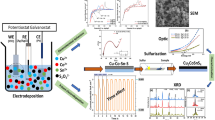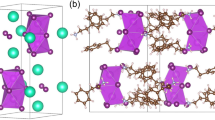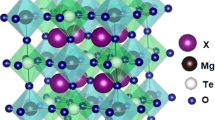Abstract
The influence of Ag as a lower-valent dopant onthe kinetics of lead iodination under normal andshort-circuit conditions in iodine pressures of 0.615 to6.578 kPa in the temperature range of 423 to 523 K was investigated. Like pure Pb, Ag-doped Pbalso follows the parabolic law of film growth. Theisothermal parabolic rate constants are found todecrease in the presence of the dopant. The iodinevapor-pressure dependence of isothermal parabolic rateconstants was observed to be kP ∝p 1/2I2 . Results for normal iodination areexplained in terms of migration of electron holes underthe influence of Cabrera-Mott's electrical field across the film. Theactivation energy for normal iodination of Ag-doped Pbis estimated to be 84 kJ•mol-1 comparedto that of 64 kJ•mol-1 for pure lead. Therate of iodide-film growth has been found to decrease further undershort-circuit mode of experiments. Such observationshave been explained with the concept of ion migration asthe ratelimiting step for the film-growth process. The iodine pressure dependence of the rateconstants under short-circuit conditions is observed tobe kP ∝ p 1/3I2 associatedwith an activation energy value of 66kJ•mol-1. Unlike pure lead, introduction of additional resistances in series to theshort-circuit Pt path during iodination of Ag-doped Pbcaused an increase in the rates with gradual increasedvalue of resistances. Kinetics results are explained by considering the prevalence ofSchottky-Wagner type of point defects in lead iodide.The driving forces for migration of the defect speciesthrough the growing pure PbI2 films andAg-doped PbI2 are confirmed to be Wagner's electrochemical potentialgradient and Cabrera-Mott's electrical field,respectively. The iodide films were characterized bySEM, EDS, EPMA, AES, and XRD analyses to substantiatethe kinetic results.
Similar content being viewed by others
REFERENCES
J. Schoonman, A. Wolfert, and D. F. Untereker, Solid State Ionics 11, 187 (1983).
A. M. Salau, Solar Energy Mater. 2, 327 (1980).
D. Z. Edwards, J. Z. Gier, Z. E. Nelson, and R. D. Roddick, J. Solar Energy, 6, 1 (1962).
C. Manfredotti, R. Murri, A. Quirini, and L. Vasanelli, IEEE Trans. Nucl. Sci. 24, 126 (1977).
J. C. Lund, K. S. Shah, M. R. Squillante, and F. Sinclair, IEEE Trans. Nucl. Sci. 35, 89 (1988).
R. I. Dawood and A. J. Forty, Phil. Mag. 8, 1003 (1963).
A. E. Dugan and H. K. Henisch, J. Phys. Chem. Solids 28, 1885 (1967).
J. F. Verway, J. Phys. Chem. Solids 31, 163 (1970).
J. Malinowsky, Photo. Sci. Eng. 15, 175 (1971).
S. Baidyaroy, W. R. Bottoms, and P. Mark, J. Phys. Chem. Solids 33, 357 (1972).
J. Schoonman, Solid State Commun. 13, 673 (1973).
A. P. Lingras and G. Simkovich, J. Phys. Chem. Solids 39, 1225 (1978).
K. Hauffe, Oxidation of Metals (Plenum Press, New York, 1965), p. 157.
W. Jost, Diffusion in Solids, Liquids and Gases (Academic Press, New York, 1952), p. 185.
N. F. Mott and R. W. Gurney, Electronic Processes in Ionic Crystals (Dover Pub., New York, 1948), p. 53.
H. K. Henisch and C. Srinivasgopalan, Solid State Commun. 4, 415 (1966).
N. L. Dmitruk, V. M. Shari, M. T. Kostyshin, and E. V. Mikhailovskaya, Sov. Phys. Semiconductor 14, 350 (1980).
S. C. Kuiry, S. K. Roy, and S. K. Bose, Mater. Res. Bull. 31, 317 (1996).
J. H. Eriksen and K. Hauffe, Proc. 5th Scand. Corros. Congr., Copenhagen, 1968, p. 38–I.
R. N. Patnaik, S. K. Bose, and S. C. Sircar, Brit. Corros. J. 12, 57 (1977).
S. K. Bose and S. C. Sircar, Trans. Indian Inst. Met. 33, 37 (1980); ibid 33, 45 (1980).
S. C. Kuiry, S. K. Roy, and S. K. Bose, Oxid. Met. 46, 399 (1996).
S. C. Kuiry, S. K. Roy, and S. K. Bose, Oxid. Met. 47, 295 (1997).
A. T. Fromhold, J. Phys. Chem. Solids 33, 95 (1972).
A. T. Fromhold, Theory of Metal OxidationÐ Fundamentals (North-Holland, Amsterdam, 1976), Vol. 1, p. 204.
R. I. Dawood and A. J. Forty, Phil. Mag. 7, 1633 (1962).
C. Tubandt, H. Reinhold, and G. Liebold, Z. Anorg. Chem. 197, 225 (1931).
G. von Hevesy and W. Seith, Z. Phys. 56, 790 (1929).
N. Cabrera and N. F. Mott, Rept. Progr. Phys. 12, 163 (1949).
S. K. Bose, S. K. Mitra, and S. K. Roy, Oxid. Met. 46, 73 (1996).
S. C. Kuiry, Ph.D Thesis, I.I.T. Kharagpur, India (1995).
O. Kubachewski and C. B. Alcock, Metallurgical Thermochemist ry (Pergamon Press, New York, 1989) p. 384.
Rights and permissions
About this article
Cite this article
Kuiry, S.C., Roy, S.K. & Bose, S.K. Kinetics and Mechanism of Iodide-Film Growth on Lead-Effect of Short-Circuiting and Lower-Valent Dopant. Oxidation of Metals 49, 431–453 (1998). https://doi.org/10.1023/A:1018855129931
Issue Date:
DOI: https://doi.org/10.1023/A:1018855129931




